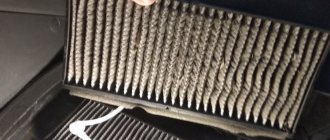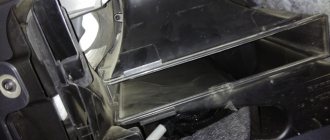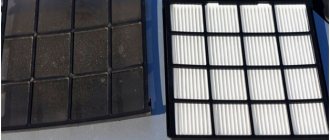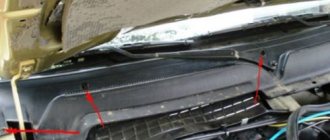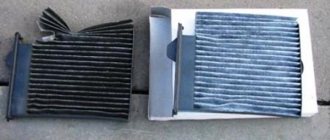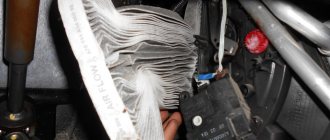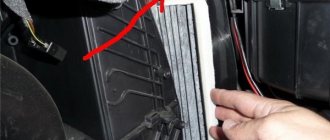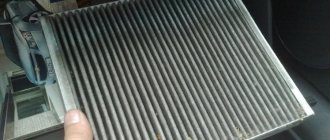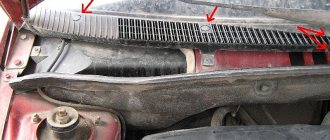One of the advantages of maximum unification of conveyor production is the similarity of maintenance procedures for different cars of the same manufacturer, down to the smallest detail. For example, having replaced the cabin filter on a Kia Rio of 2-3 generations yourself, you can find that it is changed in a similar way on other Kia passenger cars of the same class.
Considering that this procedure is more than simple, there is no need to resort to the help of a car service: you can simply change the cabin filter yourself even without any experience
How to replace?
Many people are interested in the question of how to change the cabin filter?
Simple enough! There is no need to contact service organizations here. Basically, the work consists of the simplest process of removing a component from the compartment in the glove compartment of the KIA Rio 3. Having dealt with the degree of clogging, we determine the need for replacement. If it is relevant, then remove the expired filter and install a new component, acting carefully. We do not allow the use of parts with gaps present on the working surface, because these “artifacts” can lead to a deterioration in the quality of air purification in the KIA Rio 3 cabin.
The importance of the cabin filter
The cabin filter is designed to clean the air that enters the cabin through the air intake openings from the street. The task is extremely relevant if you live in a large city. The concentration of exhaust gases on the road is high, and even with the windows closed, a huge amount of harmful substances enters the car. Air from the road contains a lot of substances hazardous to health:
- tire dust;
- small rubber particles;
- asbestos from brake pads;
- bacteria, viruses and plant spores.
If we talk specifically about the exhaust gas from a car, it includes more than 200 different toxic substances. These are oxides of carbon, sulfur and nitrogen, compounds of heavy metals, soot, hydrogen fluoride and much more. Even for a completely healthy person, a high concentration of exhaust gases is dangerous, but what can you say if you have asthma or other diseases of the respiratory system?
All these substances can lead to extremely unpleasant consequences: oxygen starvation, which causes headaches, shortness of breath and even a decrease in reaction speed. Nitrogen oxides lead to damage to the respiratory tract and lungs, while benzene, soot and formaldehyde lead to carcinogens. With constant exposure, chronic development of lung diseases is possible.
Experiments show that cabin filters are capable of trapping up to 99.5% of small and medium particles. However, as it gets dirty, of course, the part loses its effectiveness, which forces drivers to regularly replace it. We recommend not to neglect this, because your health directly depends on the quality of air in the cabin. In addition, replacing the cabin filter in the Kia Rio 3 takes just 5-7 minutes in a garage.
The process of replacing the cabin filter on Kia Rio 2010-2015
Of course, before starting work, you have to buy a new filter element. Carbon filters are considered the most recommended. Nowadays their variety is very great. Choose according to your taste.
First, you need to clear the front panel glove compartment of foreign objects.
You need to remove the side plugs.
Now, lower the glove compartment door all the way down.
Inside there will be a special shelf for the filter with clamps located on the sides. Squeezing the clips, being careful not to damage the rubber seals, remove it.
Finally, the old filter element can be replaced with a new one. At the same time, do not be afraid if it does not fit in width. In this case, simply compare the dimensions of the filters and cut the purchased one with scissors along one of the ribs.
The replacement can be considered complete. All that remains is to put everything back in reverse order and enjoy the freshness and purity of the air entering the cabin.
Why change?
The main function of the filter element is to clean the incoming air from dirt and dust particles. Over time, its throughput decreases, air circulation in the cabin worsens, humidity rises, and the windows begin to fog up.
This situation has a bad effect on visibility, especially in winter. In frosty weather, windows freeze, reducing visibility. This is one of the reasons why replacement is carried out.
An additional function of a filter, especially a carbon one, is to retain foreign odors and harmful chemicals.
Over time, all this accumulates in the filter material and after six months of operation, it no longer purifies the air, but, on the contrary, releases harmful substances into the cabin.
Therefore, if you change it on time, it helps create a healthy atmosphere and comfortable conditions inside the car.
Often, car enthusiasts do not pay enough attention to the cabin filter in their car and decide to replace it after unpleasant odors appear in the cabin when the cooling system is turned on. These odors appear during operation of the air conditioner from the evaporator and a dirty filter.
Thanks to the evaporator, the air conditioner not only cools the air, but also dehumidifies it. Therefore, the evaporator is constantly in a humid environment, which promotes the development of pathogenic microorganisms in it.
To avoid their negative impact on the body of the driver and passengers, the evaporator must be cleaned with antibacterial agents.
The quality of the filter element is of great importance in megacities, as it traps in its layers smoke, dust, soot and exhaust gases that are contained in the air on the street, especially near roads. Therefore, you should regularly replace the filter in the car's interior, especially since the replacement procedure is simple.
Replacing the cabin filter on Kia Rio 2, 3, 4
As already mentioned, the location of the interior cleaner is identical for all four generations of Kia Rio.
Necessary tools, materials:
- flat head screwdriver;
- rags;
- a vacuum cleaner or other pneumatic blower to clean the body;
- new cabin filter;
- additional lighting in the form of a flashlight if work is carried out in conditions of limited visibility.
Installation progress (see video):
- We place the car on a level platform, turn off the engine, and release the handbrake to prevent an arbitrary rollback.
- Open the front passenger door wide.
- Unclip the glove box lid.
- We lower the plastic frame down to the floor.
- Unsnap the housing cover and remove the cleaner.
- We carry out troubleshooting of the cavity, blow it with a vacuum cleaner as the need arises.
- We check the body for cracks, dents, and defects.
- Place the new filter in the “Base down” position.
- Snap the lid and insert the glove box into the grooves.
DIY installation is complete. Subsequent maintenance of Kia Rio 3 after 15,000 km. Do not buy cheap analogs or replacements for factory filters. If difficulties arise, contact service station specialists for help.
Differences in types of cabin filters
In order for a car owner to make the right choice when purchasing a new cabin filter, he needs to understand a number of issues that will indicate the strengths and weaknesses of the types of filter elements.
All cabin filters are divided into two types:
- Conventional dust filters.
- Fine air filters.
The differences between these types are as follows:
- Conventional filter elements are quite cheap. Their main disadvantages are the passage of small dust particles, lack of air purification from foreign odors, fragility and fragility. In addition, they are unable to clean the air of toxic gases.
- Fine air filters are usually made of synthetic materials or high-quality natural materials. Their main advantage is to clean the air from foreign odors and capture the smallest dust particles. The main disadvantage is, of course, the price. It starts from 400 rubles, and can even go up to 2500 rubles.
Having understood the issue of the difference between cabin filters, the car owner will be able to make the right choice when purchasing a new consumable. The choice in favor of a certain type of filter elements remains with the car owner.
Main stages of repair work
- After diagnosis, the glove compartment is removed;
- remove the cabin filter clamps;
- The purifier is replaced;
- All components are installed in reverse order.
Some car owners believe that they can replace the filter themselves. This decision is wrong. The procedure itself may not seem complicated, but only a service center will be able to determine whether it will be enough to simply replace the filter. The thing is that when the ventilation system is clogged, the radiator-evaporator suffers. If the problem is misdiagnosed, serious problems will arise in the future. The right decision is to pay a small amount of money for a routine filter replacement rather than paying several times more to fix all the problems in the future.
Step-by-step instructions for replacing the cabin filter
In order to replace the air filter on a Kia Rio, you must perform the following steps:
- Open the hood and find the filter box located behind the left (in the direction of travel) headlight of the car
- The box lid is held in place by two latches, which are located on the right edge. They snap off easily by hand.
- By lifting the cover up and to the side, you can remove the old filter. If the work is done in the cold, it is still better to pull the air duct pipe off the cover - both it and the plastic of the cover will noticeably harden, and bending deformation can lead to the appearance of cracks.
- Since the air flow goes through the filter from bottom to top, there is no need to worry about accumulated debris getting into the intake manifold - it will all remain in the box. It is worth removing it from there, otherwise at high speeds some of the old dirt will inevitably be drawn into the new filter by air
- The new filter is installed simply, there are no errors here. It is enough to get into the guides of the box, and you can install the cover in place. If the latches do not snap into place, you need to check whether its hooks on the left side have entered the grooves in the lower part of the box, and then press it harder - but, of course, observing the necessary accuracy.
Replacement procedure
First, we should tell you where the Kia Rio cabin filter is located? It is located behind the glove compartment, so access will require some minor dismantling work. Best of all, you don't need any specialized tools to perform the replacement. As a last resort, only a regular slotted screwdriver. It is fashionable to change the filter both in the garage and in an open space, preferably in good lighting.
All that remains is to find out how to change the cabin filter on a Kia Rio? Drivers just need to follow the following instructions:
- Open the glove compartment and remove all items from it. There are two limiters on the right and left inner sides. You need to pull them out. If they are difficult to give in, you can use a screwdriver. Be careful not to damage the seats.
- Lower the glove compartment all the way down and then carefully remove it from its hinges.
- Find a rectangular container in the space behind the glove compartment. It must be closed with a lid, which is secured with two clips on the sides. It is enough to squeeze the latches on both sides and pull the cover towards you.
- Remove the old filter and install the new one. Please note that the part has a special arrow-shaped indicator. The filter must be inserted so that it points down.
- Make sure that the filter fits tightly into place and is not wrinkled.
- Replace the cover by snapping the two latches into place.
- Place the glove compartment in its original position and reinstall the stoppers.
As you can see, the whole process takes 5, at most 10 minutes. The main thing is not to damage the drawer stops. If you still have questions, watch the video at the end of the page.
When to change, what interior to install
To perform scheduled maintenance operations, there are regulations, as well as manufacturer recommendations. According to them, replacing the cabin filter of the Kia Rio I DC heating and air conditioning system should be done every 15,000 kilometers or once a year.
Considering that the operating conditions of the car in most cases will be far from ideal, experts advise performing this operation approximately twice as often, in spring and autumn.
Characteristic symptoms:
- Windows often fog up;
- the appearance of unpleasant odors in the cabin when the airflow is turned on;
- deterioration of the stove and air conditioner;
They may make you doubt that the filter element is coping with its tasks and an unscheduled replacement will be required. In principle, these symptoms should be relied upon when choosing the correct replacement interval.
Suitable sizes
When choosing a filter element, owners do not always use products recommended by the car manufacturer. Everyone has their own reasons for this, some say that the original is unreasonably expensive. Some people in the region sell only analogues, so there is a need to know the sizes by which you can subsequently make a selection.
2 elements with dimensions:
- Height: 25 mm
- Width: 100 mm
- Length: 235 mm
As a rule, sometimes analogues for the Kia Rio I DC may be a few millimeters larger or smaller than the original, there is nothing wrong with that. And if the difference is measured in centimeters, then of course it’s worth looking for another option.
Selecting an original cabin filter
The manufacturer recommends using exclusively original consumables, which, in general, is not surprising. They themselves are of good quality and are widely available in car dealerships, but their price may seem overpriced to many car owners.
Regardless of the configuration, on all first-generation Kia Rios (including the restyled version), the manufacturer recommends installing a cabin air filter with article number 97619-FD200 (97619FD200).
The salon in this model is composite and consists of 2 parts. They are completely identical in size, the only difference being the so-called tongue-and-groove system on the side plastic edges.
It is worth noting that sometimes consumables and other spare parts may be supplied to dealerships under different part numbers. Which can sometimes confuse those who want to purchase an original product.
When choosing between a dust and carbon product, car owners are advised to use a carbon filter element. This filter is more expensive, but it cleans the air much better.
It is easy to distinguish - the paper filter accordion is impregnated with a carbon composition, and therefore has a dark gray color. The filter cleans the air flow from dust, fine dirt, germs, bacteria and enhances the protection of your lungs.
Which analogues to choose
In addition to simple cabin filters, there are also carbon filters that filter the air more effectively, but they are more expensive. The advantage of coal SF is that it does not allow foreign odors coming from the road (street) to penetrate into the car interior.
But this filter element also has a drawback - air does not pass through it well. GodWill and Corteco carbon filters are of fairly high quality and are a good replacement for the original.
However, in some retail outlets the price of the original first-generation Kia Rio cabin filter may be greatly inflated. In this case, it makes sense to purchase a non-original consumable item. In particular, cabin filters are considered quite popular:
Conventional dust cabin filters
- Mann Filter CU 2521-2 – high-tech consumables from a well-known manufacturer
- Amd FC45 – popular brand, good fine cleaning
- Nevsky filter NF-6167-2 - Russian manufacturer with an affordable price
Carbon cabin filters
- Amd FC45C – high-quality and thick carbon coating
- BIG filter GB9935/C – activated carbon
- Nevsky filter NF6167C2 – normal quality, affordable price
It makes sense to take a closer look at the products of other companies - they also specialize in the production of high-quality consumables for passenger cars:
- Corteco
- Filtron
- SCT
- Sakura
- GoodWill
- Fram
- JS Asakashi
- Champion
- Zekkert
- Masuma
- Nipparts
- Purflux
- Knecht Mahle
- RU54
It is quite possible that sellers may recommend replacing the Rio I DC cabin filter with non-original cheap substitutes with a much smaller thickness. They are not worth buying, since their filtering characteristics are unlikely to be at the proper level.
Which filter to buy: varieties
Please note that models supplied to Russia are versions for China, and not for Europe. Accordingly, if you bought a foreign car in the Russian Federation, then you need the following article number for the filter - catalog number 97133-OSOOO. This is a filter for models before 2012 that have not yet been restyled. The filter involves only rough cleaning (only from leaves, therefore, it is not able to retain dust), so drivers buy non-original, but more advanced models such as MANN CU1828, MAHLE LA109, VALEO 698681 or TSN 9.7.117.
If we talk about models after 2012, then a classic filter is already used here, designated in the catalog - 97133-4L000. If you are looking for its analogues, we recommend looking at TSN 9.7.871, Filtron K1329, MANN CU21008. According to many drivers, the quality of original and non-original models is practically the same. Considering the frequent replacement of this component, it makes no sense to overpay for a branded part.
The price of filters is quite varied. The simplest and cheapest models can be found for 150-200 rubles. It’s difficult to call them effective, so we recommend choosing something from the middle price range. The most expensive models with high filtering qualities can cost up to 3,500 rubles. Some drivers try to make filters themselves. Technically, this task is feasible, but it is difficult to make a high-quality filter that fits exactly into the slot in the car.
Additionally, you can always find a lot of other filters on the Internet that may well be compatible with your foreign car. If you are going to buy a third-party Kia Rio 3 cabin filter, we recommend that you familiarize yourself with the general classifications and key advantages of each type:
- Anti-dust filter. It is a rectangular structure made of cellulose or synthetic fibers with corrugated paper. The key benefits of these filters include their affordable price and the ability to filter pollen and other small particles. Disadvantages - such a filter does not absorb unpleasant odors and does not cope with toxic substances. The highest quality models have a service life of up to 30 thousand kilometers.
- Carbon filter. Made of synthetic fiber that stops small particles (down to 1 micrometer) due to electrostatic voltage. Able to cope with 95% of all harmful substances and convert ozone into oxygen. The only drawback is the high cost of production. Some of the most durable ones can be used for 60 thousand kilometers.
Make your choice based on filter compatibility with your machine and your budget.
How to diagnose the problem?
Here it will be useful to determine the true need to replace the part, as well as where it is located. Smells in the cabin cannot fully indicate the fact of a blockage.
Here you need to independently verify the degree of clogging of the filter component. And know how to change the cabin filter.
- Given the need for verification, we proceed to action. Open the glove compartment lid and unfasten the latches present inside, which are located on the side surfaces.
- Kia Rio 3 allows you to diagnose without resorting to special efforts. Here you will need to rotate the element 360 degrees and remove it towards you.
- In the second generation of the popular model, the clamps had a composite design, and considerable effort was required to loosen them.
- Let's continue. After deactivating the fasteners, the filter element appears before the eye.
- Removal requires simple dismantling of the latches, after which the cover becomes accessible.
- We set it aside to provide sufficient access to the frame of the filter element itself.
- Only after removing the frame will it be possible to remove the filter and assess the degree of contamination of its working surface. We determine the condition by color. For a gray filter, vacuuming will be sufficient. If the element shows a black or dark gray tint, then it will need to be replaced in order to stop the harmful effects on the health of the people present in the Kia Rio 3 cabin.
Signs of filter wear
As mentioned earlier, it is recommended to change the filter more often than indicated in the regulations, because in fact the documentation indicates the service life under optimal conditions. This raises the question: how can we determine that the filter has become unusable? Here are a few signs that will help you:
- Fogging of the windshield is one of the most common signs that indicates that the Kia Rio 3 cabin filter needs to be changed.
- The appearance of foreign odors in the cabin in the presence of a carbon filter. This means that it has exhausted its absorbent capacity.
- Changes in microclimate and malfunctions of the heating system. A clogged filter may be causing temperature fluctuations.
- Insufficient air flow in the cabin.
- The inside of the dashboard and windshield began to get dirty much faster.
The suitability of a filter can also be judged by its appearance. If it has acquired a distinctly gray or even black-brown tint, feel free to change it. Do not attempt to wash or blow out filters. These methods are ineffective and therefore are not able to completely remove all contaminants. Considering the relatively low cost, it is much easier to change the cabin filter on a Kia Rio.
